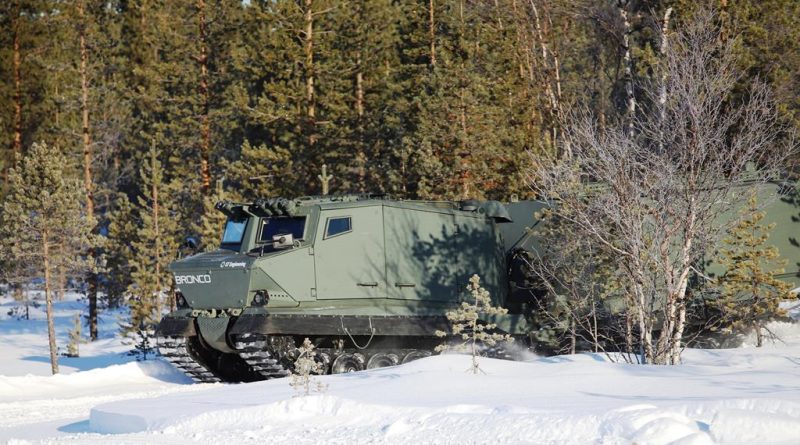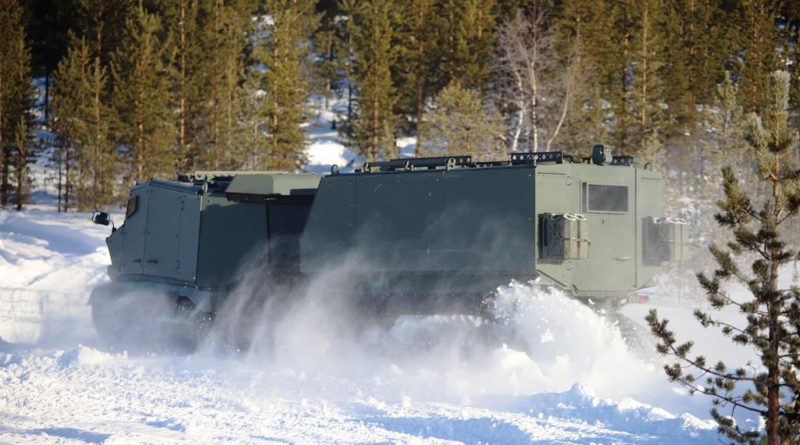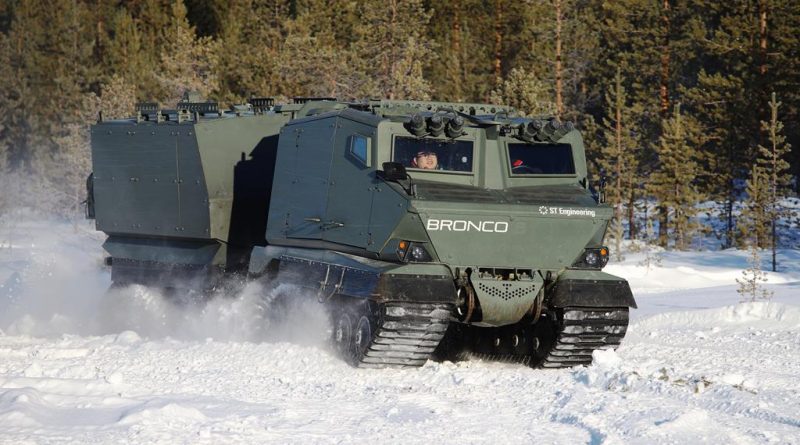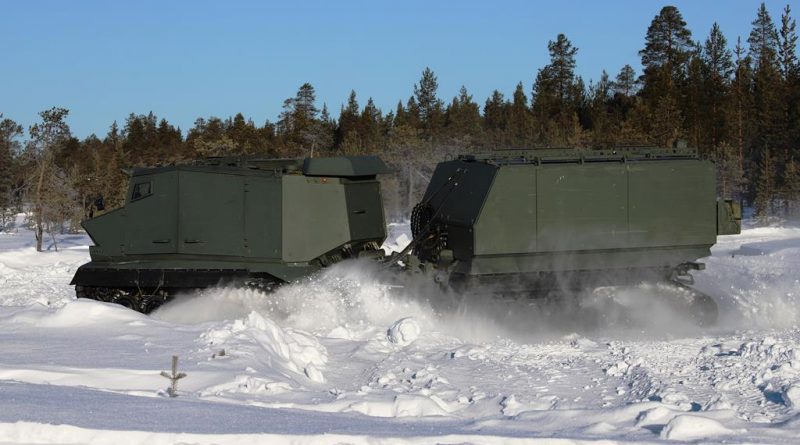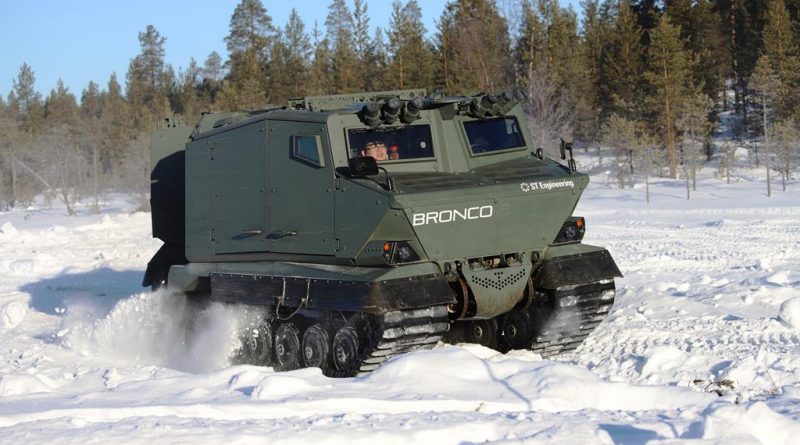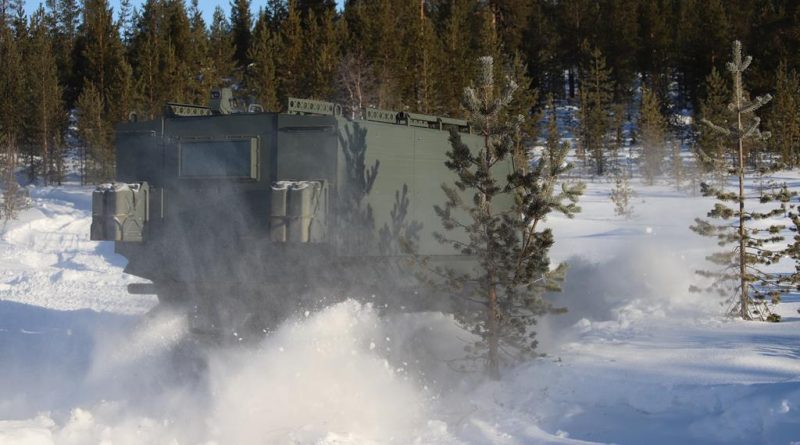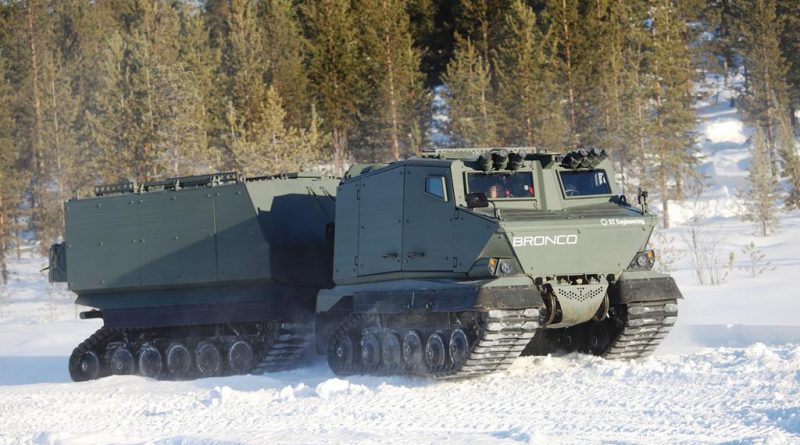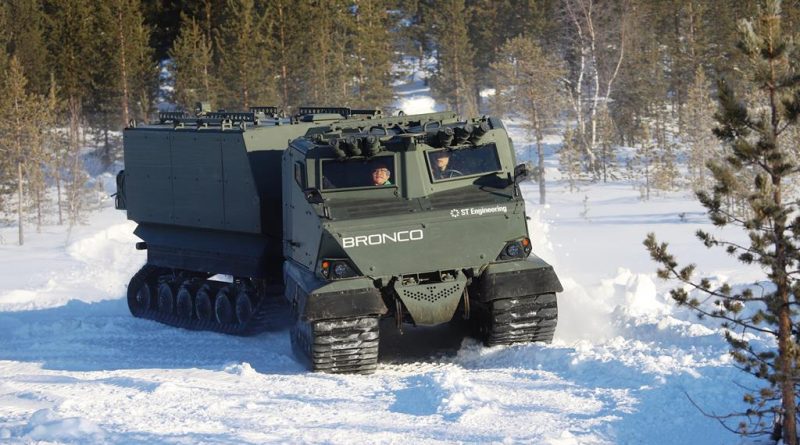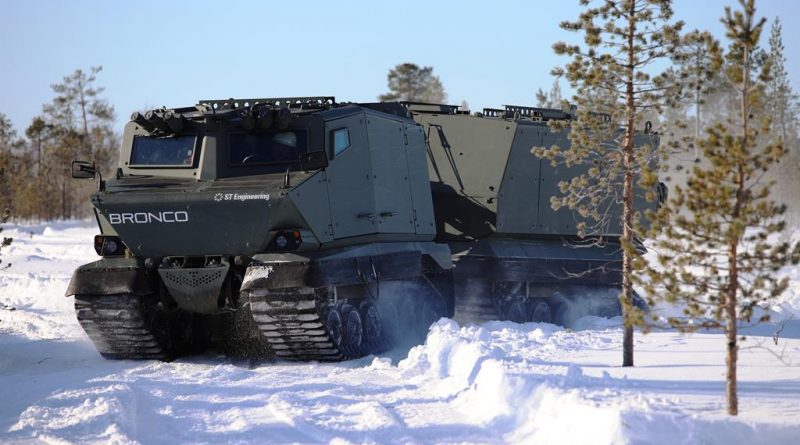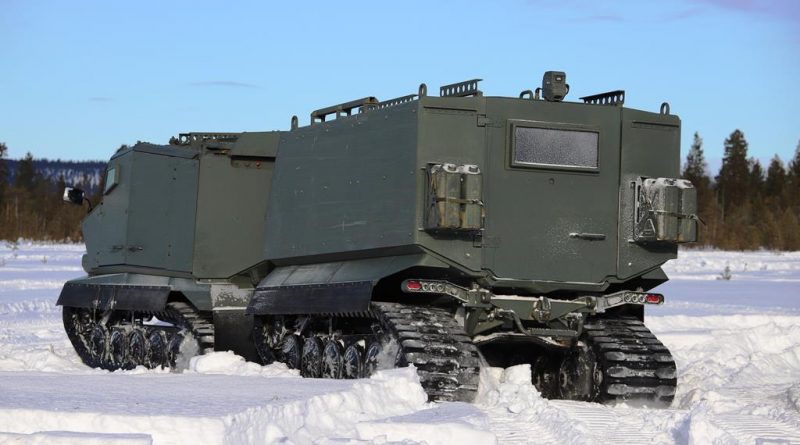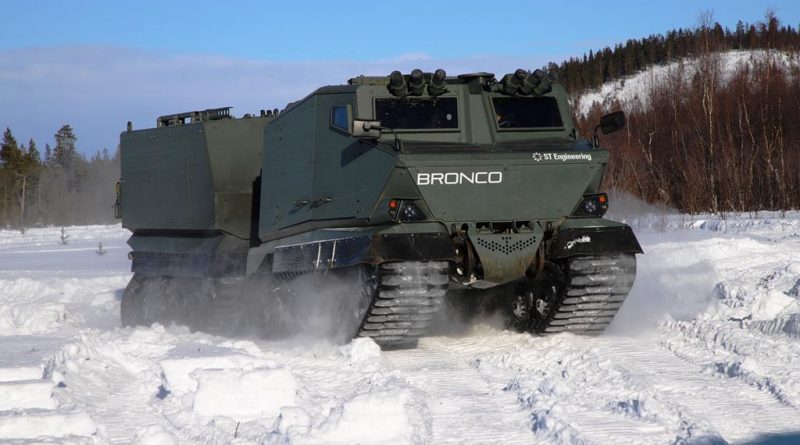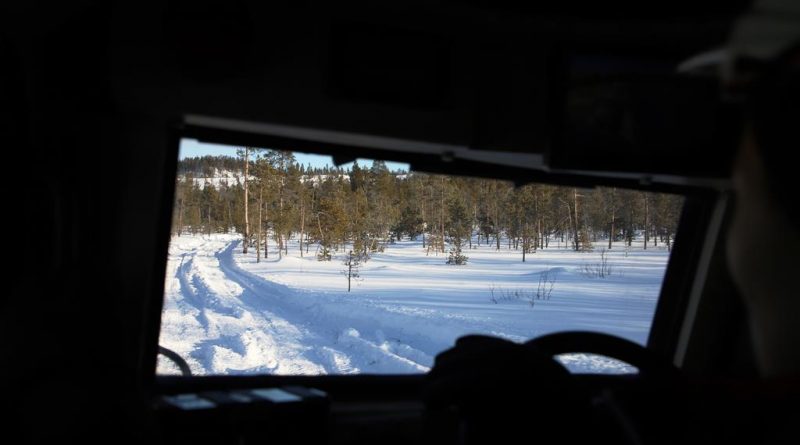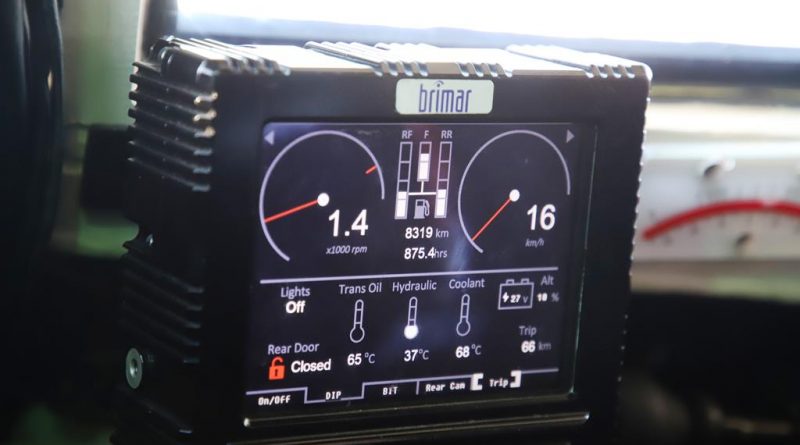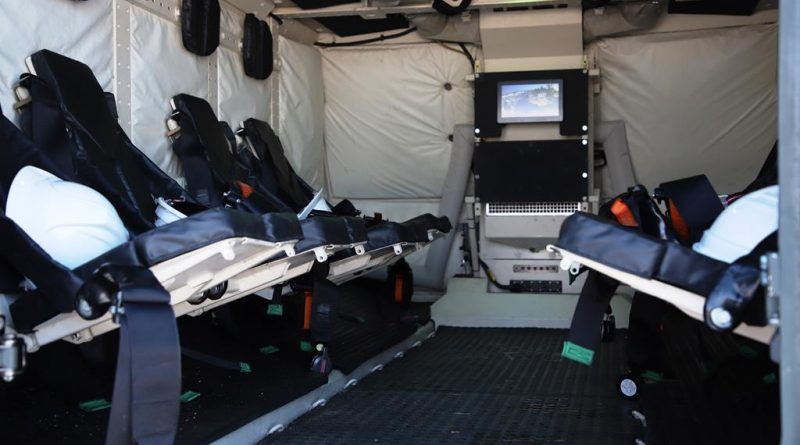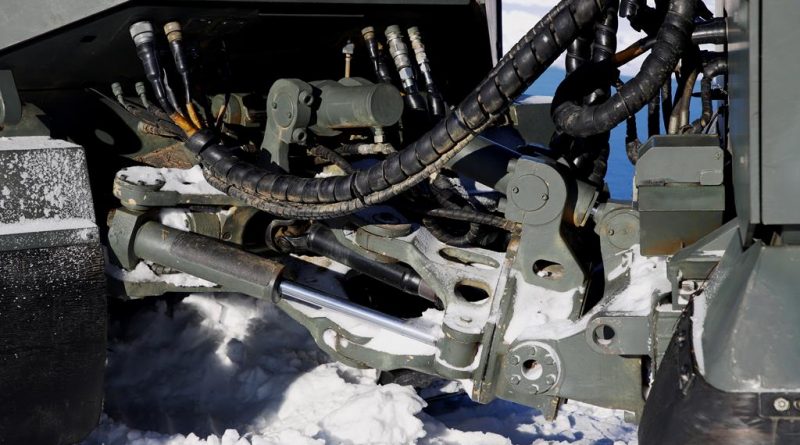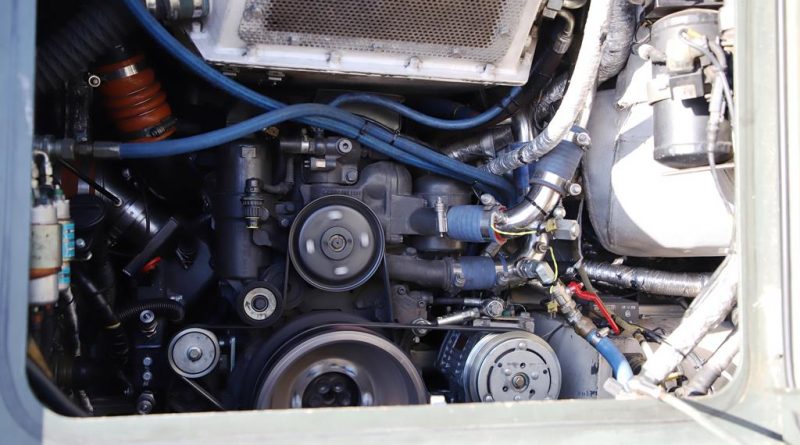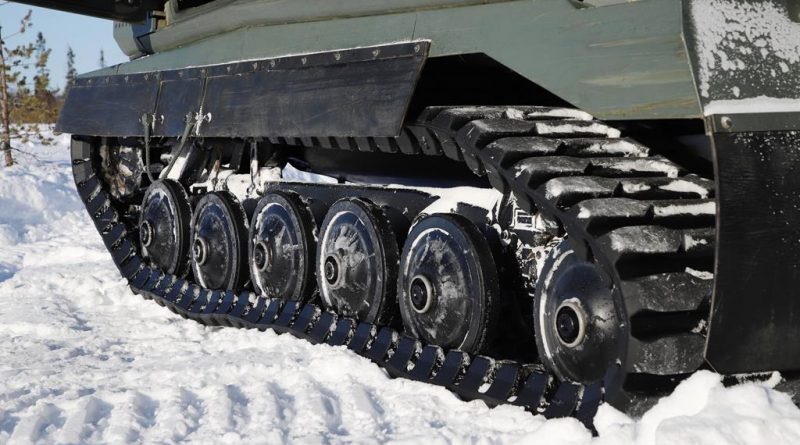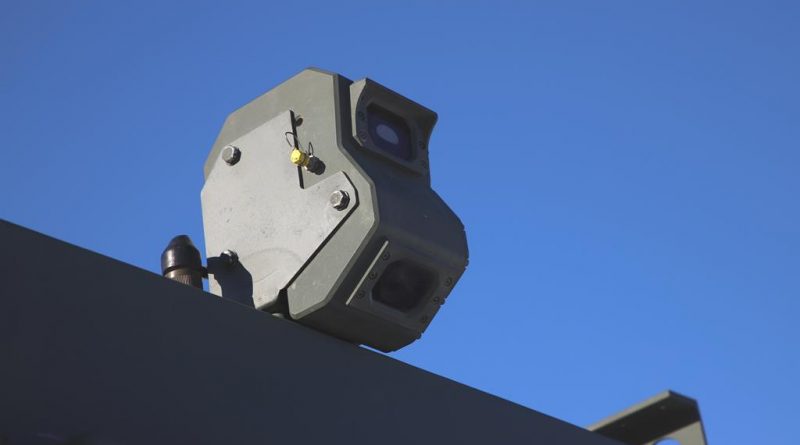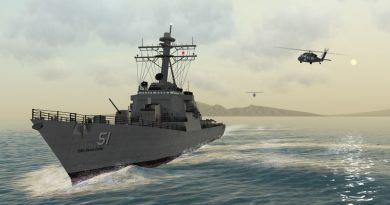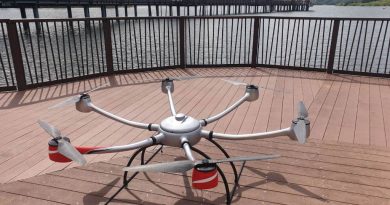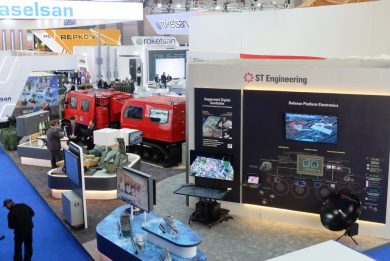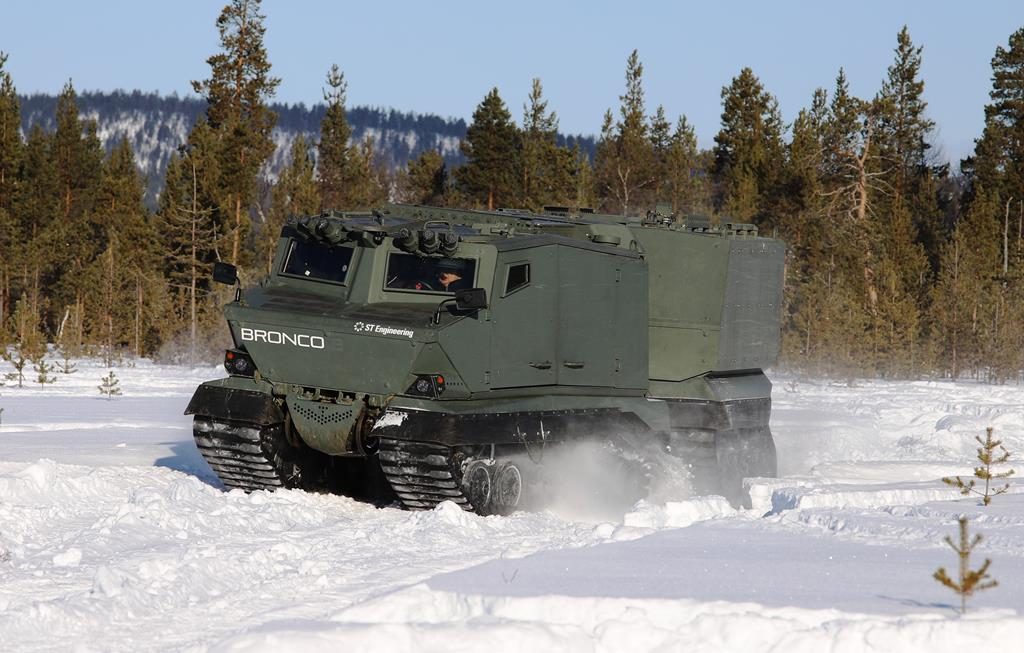
Bronco 3 at Ivalo: Singapore on Ice!
By Paolo Valpolini
“When in the 1960s Singapore became independent it had no Armed Forces and no industry, so we had to create both, conscript forces being raised while the defence industry support was provided by Chartered Industries of Singapore, the ancestor of today ST Engineering,” Dominic Phoon, Vice-President and Product Director at ST Engineering Land Systems explains to a small group of specialised journalist gathered at Ivalo Test World, the company part of the Millbrook Group, based in northern Finland and specialised in tyre and vehicle winter testing.
“We have to make it simple to train them and to reduce the sustainment footprint,” he adds, and being at the wheel of the Bronco 3, the last born of the articulated all terrain vehicles family born in Singapore, confirms this. Once pushed the brake pedal to free the hand brake and put the automatic transmission on “Drive”, it is sufficient to push the right pedal to get the vehicle on the move, the MAN Mercedes diesel engine providing 325 hp accelerating the 10.2 tonnes kerb weight Bronco, which today has quite a light payload on board but that can reach up to 16.5 tonnes, with a growth potential up to 18 tonnes. Steering is quite different from wheeled and tracked vehicles: here the steering is provided by the angle made by the front and rear wagon, but it is pretty easy to adapt to this type of feeling, the number of turns that the small wheel has to do to do steep turns being quite high, the trick to return to the neutral position being to count the turns of the wheel, so that once the turn is finished it is sufficient to turn the other way for the same number of turns and the two wagons are back to alignment.
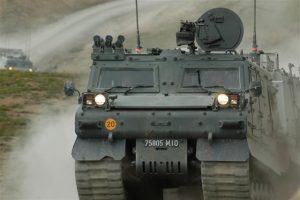 When in the late 1990s the Singapore Army expressed the need for an articulated all-terrain vehicle, then Singapore Technologies Kinetics (ST Kinetics) in cooperation with Singapore’s Defence Science & Technology Agency (DSTA), developed the Bronco, the first of over 600 vehicles having been delivered in mid-2001. The twin chassis articulated vehicle featured four rubber tracks provided by Soucy of Canada, and was powered by a Caterpillar C7 engine providing 350 hp, coupled to an Allison MD 3500 fully automatic transmission. At 16 tonnes combat weight, the Bronco had a payload of 4 tonnes, the mobility on soft terrain being ensured by the low specific ground pressure provided by the wide rubber tracks and of course by the vehicle’s architecture, which made it a tracked 4×4. Amphibious, in water it was propulsed by the movement of the tracks at up to 4.5 km/h.
When in the late 1990s the Singapore Army expressed the need for an articulated all-terrain vehicle, then Singapore Technologies Kinetics (ST Kinetics) in cooperation with Singapore’s Defence Science & Technology Agency (DSTA), developed the Bronco, the first of over 600 vehicles having been delivered in mid-2001. The twin chassis articulated vehicle featured four rubber tracks provided by Soucy of Canada, and was powered by a Caterpillar C7 engine providing 350 hp, coupled to an Allison MD 3500 fully automatic transmission. At 16 tonnes combat weight, the Bronco had a payload of 4 tonnes, the mobility on soft terrain being ensured by the low specific ground pressure provided by the wide rubber tracks and of course by the vehicle’s architecture, which made it a tracked 4×4. Amphibious, in water it was propulsed by the movement of the tracks at up to 4.5 km/h.
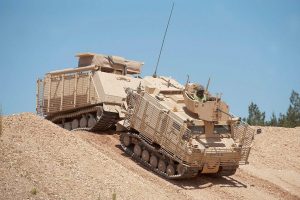 In 2007-08 Thailand became the first export customer for the Bronco Singaporean vehicle, its Broncos being mostly used by engineers. Heavily involved in Afghanistan, in 2008 the British Army acquired over 100 Warthogs, a derivative of the Bronco also dubbed Bronco 2, the first vehicle entering service in late 2009. The Warthogs featured increased protection and a Platt protected machine gun post on top of the forward module. Increase in protection came at a cost for payload: kerb weight went up to 14.5 tonnes, troops in Afghanistan using the vehicle well above the nominal GVW, reaching up to 21 tonnes. That said, combat the vehicle allowed saving lives in the Helmand Valley, no fatalities having occurred on Warthogs hit by IEDs.
In 2007-08 Thailand became the first export customer for the Bronco Singaporean vehicle, its Broncos being mostly used by engineers. Heavily involved in Afghanistan, in 2008 the British Army acquired over 100 Warthogs, a derivative of the Bronco also dubbed Bronco 2, the first vehicle entering service in late 2009. The Warthogs featured increased protection and a Platt protected machine gun post on top of the forward module. Increase in protection came at a cost for payload: kerb weight went up to 14.5 tonnes, troops in Afghanistan using the vehicle well above the nominal GVW, reaching up to 21 tonnes. That said, combat the vehicle allowed saving lives in the Helmand Valley, no fatalities having occurred on Warthogs hit by IEDs.
Overall more than 1,200 vehicles have been delivered in at least 20 different versions, many more having been developed by what is now ST Engineering Land Systems.
The Bronco 3
With its first international appearance at DSEI 2017, the Bronco 3 leverages the experience and lessons learned acquired downrange with the previous models, the first aim being that of bringing back the payload to its origins while maintaining the vehicle’s combat weight.
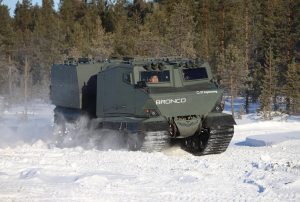 ST Engineering designers worked hard to obtain this, and finally succeeded in reducing the kerb weight by over 2 tonnes. Among the various modifications we find a new engine, in the form of a Mercedes-MTU TD106 providing 325 hp, 25 hp short of the previous one but with a much higher torque, a key element when travelling cross-country; besides improving off-road performances it also reduces fuel consumption. Not only, the engine is more compact and light; it is located at the back of the front cabin, and maintenance is eased by a huge door hinged on the right that allows full access to the power pack from the back of the module. Dual use of some elements, i.e. some structural tubes used also as pipes, also allowed reducing the kerb weight, which in the end became 10.2 tonnes, 1 tonne less than the original Bronco 1 and over 2 tonnes less than the Warthog, giving the vehicle a full 6.3 tonnes payload, considering 16.5 tonnes the GVW limit, that for amphibious operations being 16 tonnes, however floating elements can be added should the need arise to cope with water obstacles at a higher GVW. The redesign of the front module allows now to navigate without the need of raising a trim vane, a time-consuming and dangerous operation when under fire, the only operation to be made being raising the front of the forward module acting onto the hydraulic system that links it to the rear.
ST Engineering designers worked hard to obtain this, and finally succeeded in reducing the kerb weight by over 2 tonnes. Among the various modifications we find a new engine, in the form of a Mercedes-MTU TD106 providing 325 hp, 25 hp short of the previous one but with a much higher torque, a key element when travelling cross-country; besides improving off-road performances it also reduces fuel consumption. Not only, the engine is more compact and light; it is located at the back of the front cabin, and maintenance is eased by a huge door hinged on the right that allows full access to the power pack from the back of the module. Dual use of some elements, i.e. some structural tubes used also as pipes, also allowed reducing the kerb weight, which in the end became 10.2 tonnes, 1 tonne less than the original Bronco 1 and over 2 tonnes less than the Warthog, giving the vehicle a full 6.3 tonnes payload, considering 16.5 tonnes the GVW limit, that for amphibious operations being 16 tonnes, however floating elements can be added should the need arise to cope with water obstacles at a higher GVW. The redesign of the front module allows now to navigate without the need of raising a trim vane, a time-consuming and dangerous operation when under fire, the only operation to be made being raising the front of the forward module acting onto the hydraulic system that links it to the rear.
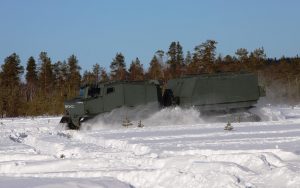 The Bronco 3 redesign went much further than a mere sliming cure, numerous solutions allowing increasing protection. The last iteration of the Bronco has a V-shaped underbelly, produced in a single plate and therefore much more apt to withstand a blast; EDR On-Line understood that ST Engineering is using Armox 440T plates from SSAB of Sweden for belly protection, Armox 500T being the choice for ballistic protection. To further increase mine/IED protection in the rear wagon, this has now a 1 meter ground clearance, the roof having being heighted to ensure greater volume, 7.9 m3 for the rear while the front module has a 5.2 m3 protected volume. Moreover the most dangerous elements in the cabins, that might have injured soldiers in case of mine/IED incident, have been removed and relocated, increasing the inside space. The occupants’ position has also been reviewed: in the front module the driver, on the left, and the commander, on the right, now seat together at the centre of the vehicle and not on top of tracks, all other occupants having also been relocated the further possible from the tracks. Suspended seats are provided to all the occupants to further reduce the risk of injuries. EDR On-Line understood that a Level 2a/b against mines has been reached. It is also to note that the two main fuel tanks are fitted under the rear module floor, adding to protection, the fluid being able to dissipate part of the blast energy; the fuel is transferred by an automatic pumps system into a smaller 40-50 litres tank located in the forward module, which then feeds the engine.
The Bronco 3 redesign went much further than a mere sliming cure, numerous solutions allowing increasing protection. The last iteration of the Bronco has a V-shaped underbelly, produced in a single plate and therefore much more apt to withstand a blast; EDR On-Line understood that ST Engineering is using Armox 440T plates from SSAB of Sweden for belly protection, Armox 500T being the choice for ballistic protection. To further increase mine/IED protection in the rear wagon, this has now a 1 meter ground clearance, the roof having being heighted to ensure greater volume, 7.9 m3 for the rear while the front module has a 5.2 m3 protected volume. Moreover the most dangerous elements in the cabins, that might have injured soldiers in case of mine/IED incident, have been removed and relocated, increasing the inside space. The occupants’ position has also been reviewed: in the front module the driver, on the left, and the commander, on the right, now seat together at the centre of the vehicle and not on top of tracks, all other occupants having also been relocated the further possible from the tracks. Suspended seats are provided to all the occupants to further reduce the risk of injuries. EDR On-Line understood that a Level 2a/b against mines has been reached. It is also to note that the two main fuel tanks are fitted under the rear module floor, adding to protection, the fluid being able to dissipate part of the blast energy; the fuel is transferred by an automatic pumps system into a smaller 40-50 litres tank located in the forward module, which then feeds the engine.
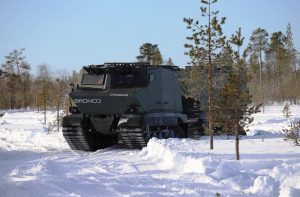 Coming to basic ballistic protection, baseline protection remains at Level 2, and can be brought up to Level 4 with add-on kits which can easily fit within the 6.3 tons of payload available. According to ST Engineering designers a Level 3 kit including side modules, dimensioned in order to be transportable by soldiers and installed on the field without the need of a crane or other specialised equipment, and Level 3 transparents, would add around 1 tonne, thus leaving a good 5.3 tonnes payload. However the Bronco 3 can operate also at higher payloads, the limit being considered 18 tonnes without any mobility degradation. Automotive elements can withstand even a higher combat weight: in Afghanistan the Warthog operated up to 21 tonnes, and as the Bronco 3 maintains exactly the same chassis this is also possible for the younger element of the Bronco family. However wear and tear of rubber tracks halved their operational life from 10,000 to 5-6,000 km, while as far as mobility is concerned the most critical situation in that case becomes the mud. Standard tracks are 600 mm wide, however 650 mm tracks with steel elements, designed mostly for the use in the Alps are available, as well as 700 mm ones that allow a reduction of specific ground pressure at increased GVW.
Coming to basic ballistic protection, baseline protection remains at Level 2, and can be brought up to Level 4 with add-on kits which can easily fit within the 6.3 tons of payload available. According to ST Engineering designers a Level 3 kit including side modules, dimensioned in order to be transportable by soldiers and installed on the field without the need of a crane or other specialised equipment, and Level 3 transparents, would add around 1 tonne, thus leaving a good 5.3 tonnes payload. However the Bronco 3 can operate also at higher payloads, the limit being considered 18 tonnes without any mobility degradation. Automotive elements can withstand even a higher combat weight: in Afghanistan the Warthog operated up to 21 tonnes, and as the Bronco 3 maintains exactly the same chassis this is also possible for the younger element of the Bronco family. However wear and tear of rubber tracks halved their operational life from 10,000 to 5-6,000 km, while as far as mobility is concerned the most critical situation in that case becomes the mud. Standard tracks are 600 mm wide, however 650 mm tracks with steel elements, designed mostly for the use in the Alps are available, as well as 700 mm ones that allow a reduction of specific ground pressure at increased GVW.
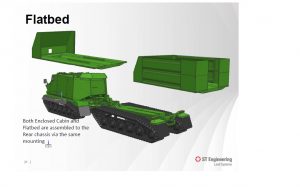 While the superstructure of the front module is fix, the citadel protecting the four soldiers at front, the rear module is coupled to the chassis. Currently the coupling is done with standard bolts, however the adoption of ISO locks might make the operation even quicker. Inside the APC rear wagon modular rails have been installed, allowing easy fitting of mission-related equipment, a screen allowing the eight dismounts to see the situation provided by the BMS or outside views prior to debussing being located in the forward wall of the rear module. The 550 A power supply allows integrating any possible type of system without any problem.
While the superstructure of the front module is fix, the citadel protecting the four soldiers at front, the rear module is coupled to the chassis. Currently the coupling is done with standard bolts, however the adoption of ISO locks might make the operation even quicker. Inside the APC rear wagon modular rails have been installed, allowing easy fitting of mission-related equipment, a screen allowing the eight dismounts to see the situation provided by the BMS or outside views prior to debussing being located in the forward wall of the rear module. The 550 A power supply allows integrating any possible type of system without any problem.
Looking at the future
For ST Engineering defence represents 35% of its turnover, commercial activities making around two thirds of the Group business. In some cases technology developments carried out by the commercial branches of ST Engineering can become profitable to the defence sector.
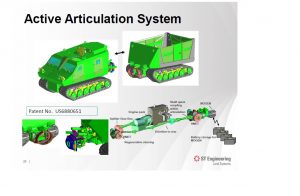 It is the case of electric and hybrid drives, as well as that of autonomy vehicles. Such technologies can definitely find an application in military vehicles, after a ruggedization process to allow them to cope with the harder conditions and with enemy threats. ST Engineering Land Systems has already developed a hybrid technology demonstrator “but this goes back some 10 years, and we were definitely anticipating too much any possible requirement,” Dominic Phoon says. The idea on the table is to build a vehicle with an architecture similar to that of the Bronco that should however have a space management much different from that of the current vehicle. The forward module would carry the engine and the rear one a motor generator, the two modules being linked by a quick coupling shaft with articulation. A series of batteries, probably Lithium-Ion, would be fitted at the back. Should the need arise the two modules could be separated operating then each on its own, the rear one exploiting the motor-generator to activate its tracks, range on batteries being estimated in 20 km. The electric driven module might be fitted with unmanned driving capabilities, becoming then autonomous, this allowing to use it for the most dangerous missions, eventually tele-operated from the manned module. But other solutions might be adopted. What is clear is that in that case steering would have to be done in a different way compared to the articulated architecture, skid steering becoming a must, while fuel must be relocated in the module carrying the engine.
It is the case of electric and hybrid drives, as well as that of autonomy vehicles. Such technologies can definitely find an application in military vehicles, after a ruggedization process to allow them to cope with the harder conditions and with enemy threats. ST Engineering Land Systems has already developed a hybrid technology demonstrator “but this goes back some 10 years, and we were definitely anticipating too much any possible requirement,” Dominic Phoon says. The idea on the table is to build a vehicle with an architecture similar to that of the Bronco that should however have a space management much different from that of the current vehicle. The forward module would carry the engine and the rear one a motor generator, the two modules being linked by a quick coupling shaft with articulation. A series of batteries, probably Lithium-Ion, would be fitted at the back. Should the need arise the two modules could be separated operating then each on its own, the rear one exploiting the motor-generator to activate its tracks, range on batteries being estimated in 20 km. The electric driven module might be fitted with unmanned driving capabilities, becoming then autonomous, this allowing to use it for the most dangerous missions, eventually tele-operated from the manned module. But other solutions might be adopted. What is clear is that in that case steering would have to be done in a different way compared to the articulated architecture, skid steering becoming a must, while fuel must be relocated in the module carrying the engine.
The small screen on the left of the driver shows two main data, that on the left being the engine rounds per minute while that on the right is the speed in km/h; icons between the two show the fuel situation in the rear and front tanks, other vital engine parameters being shown in the lower section. Following the tracks in the deep snow becomes more 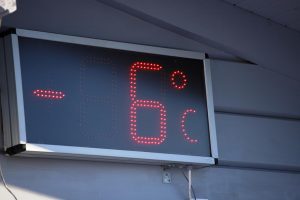 and more easy, but unfortunately our driving session is coming to an end, now that we got easily acquainted to turning the small wheel the right number of times to direct the Bronco. Following a two-day demonstration to potential customers and one day with the media, the ST Engineering technicians will remain one more week to log some distance under the rubber tracks in the heavy snow and cold weather: although not so cold by local standards, the -6°C in the middle of the day must have been quite a shock to a vehicle born in a place where at the same moment the temperature was 40°C higher. With the end of cold weather testing the industrial test programme is nearly completed, but the Bronco 3 is anyway ready for production, ST Engineering having an assembly line ready to produce 8 vehicles per months in one single shift, a rate that can easily be doubled should the need arise working on two shifts. “We aim at existing Bv206 users that need to replace their vehicles,” Dominic Phoon concludes, explaining that “countries like Canada and the USA in North America and Chile in South America are obvious targets, many European countries being also key Bv users, while in Asia there might be room for dual use vehicles,” which might be owned by the military but used also for disaster relief operations.
and more easy, but unfortunately our driving session is coming to an end, now that we got easily acquainted to turning the small wheel the right number of times to direct the Bronco. Following a two-day demonstration to potential customers and one day with the media, the ST Engineering technicians will remain one more week to log some distance under the rubber tracks in the heavy snow and cold weather: although not so cold by local standards, the -6°C in the middle of the day must have been quite a shock to a vehicle born in a place where at the same moment the temperature was 40°C higher. With the end of cold weather testing the industrial test programme is nearly completed, but the Bronco 3 is anyway ready for production, ST Engineering having an assembly line ready to produce 8 vehicles per months in one single shift, a rate that can easily be doubled should the need arise working on two shifts. “We aim at existing Bv206 users that need to replace their vehicles,” Dominic Phoon concludes, explaining that “countries like Canada and the USA in North America and Chile in South America are obvious targets, many European countries being also key Bv users, while in Asia there might be room for dual use vehicles,” which might be owned by the military but used also for disaster relief operations.
Photos by Paolo Valpolini, UK MoD, Singapore MoD, viewgraphs by ST Engineering
Gallery: photos by Paolo Valpolini

